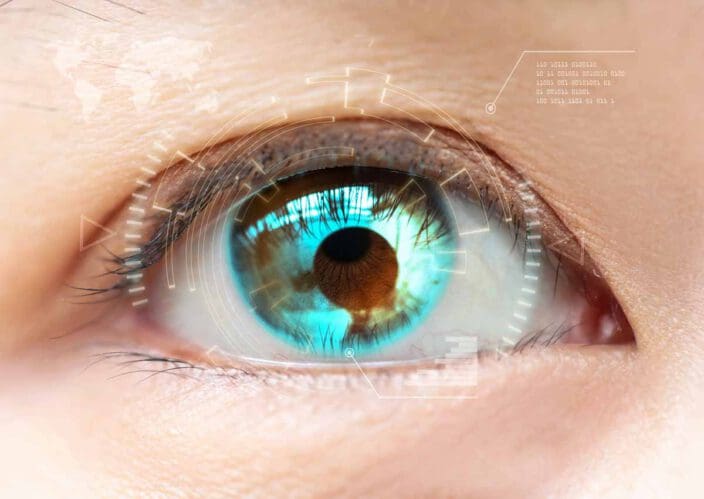
Medically Reviewed by Angelique J. Pillar, M.D.
Further Reading
Does Cataract Surgery Get Rid of Floaters or Does it Cause Them?
Home / Guide to Cataract Surgery /
Last Updated:

Medically Reviewed by Angelique J. Pillar, M.D.
Floaters cannot be fixed during cataract surgery. In fact, cataract surgery often increases your awareness of floaters.
Table of Contents
Other problems can be fixed during cataract surgery, such as these:
- Glaucoma
- Myopia
- Hyperopia
- Astigmatism
- Presbyopia
Addressing more than one issue during one surgical procedure can obviously mean fewer procedures, but it can also increase the likelihood of potential complications. Talk to your doctor to find out if one surgery is better for your situation than multiple procedures.

Floaters & Cataract Surgery
Floaters are spots in your vision that can drift around your eyes and cause annoyance. They develop in the vitreous fluid of your eye, and they are a common side effect of aging.
They are also common in people who have had cataract surgery. It is probable that floaters are not caused by cataract surgery directly. Instead, the replacement of the cloudy lens with a clear one just makes the floaters more apparent. When a cataract matures, its size grows and swells in comparison to a normal lens. A clear replacement intraocular lens is much more compact than the cloudy swollen lens. As a result of the smaller thickness, the vitreous gel behind the clear intraocular lens also has a little bit more room to move which can make the vitreous floaters appear more noticeable.
You deserve clear vision. We can help.
With 135+ locations and over 2.5 million procedures performed, our board-certified eye surgeons deliver results you can trust. Your journey to better vision starts here.
Vitrectomy, which is the surgical procedure to remove the gel of the eye, be effective at removing visually significant floaters. A vitrectomy surgery is considered more invasive than cataract surgery, however. It is not generally recommended unless the floaters are significantly impairing vision and quality of life.
If floaters appear after cataract surgery, talk to your doctor. They can be a sign of a retinal tear that will need to be managed to avoid retinal detachment.
If the exam shows no tears or holes in your retina, the floaters can usually be left alone. Often, they will decrease or disappear in time. If not, laser surgery can be done to break up the floaters. This is a much less invasive approach than vitrectomy.
Pros & Cons of Addressing Multiple Issues in One Surgery
There are many benefits to managing multiple issues during a single procedure.
You only need to take time off work one time and have one recovery period. The recovery can be longer if more issues are addressed simultaneously, however. The procedure can be more invasive and come with more potential complications and risk factors associated with it.
Insurance will often cover cataract surgery if you go with a standard IOL. If you decide on a specialized lens, such as a multifocal, accommodative, toric, or EDOF IOL, you will likely have to pay some out-of-pocket expenses. Cost can become an issue.
Since you may need to have more than one cataract surgery for each eye, it can be difficult to adjust to a corrective lens in only one eye for a few weeks. This is a short-term issue, and you can use corrective contacts or eyeglasses while you wait for the second surgery.
Addressing refractive errors during cataract surgery can potentially mean that you will no longer need prescription eyewear, which can be a major bonus. Remember that your eyes will continue to deteriorate with age, and that can mean that refractive errors are still probable over time.
Certain factors can decrease the likelihood of a successful combination procedure, such as these:
- Advanced age
- Secondary illness
- Poor eye and overall health
- Low tolerance for medications
Discuss the pros and cons of all procedures and options at length with your surgeon and eye care professionals. While cataract surgery can’t fix floaters, it can address certain other eye issues, so a combination procedure may be worth it for your specific case.
One Surgery for More Than One Problem
You may decide to address more than one problem in your eye during cataract surgery. The following issues can be managed together with cataract surgery:
- Glaucoma: This issue is related to high pressure in the eye that presses on the optic nerve. Cataract surgery can serve as a method of reducing pressure in the eye.
- Astigmatism: With astigmatism, the eye’s shape is distorted. A specialized lens can be placed during cataract surgery to correct this issue.
- Myopia: This is nearsightedness. Low-level myopia can be corrected through a prescription lens.
- Hyperopia: Farsightedness, or hyperopia, can also be managed during cataract surgery with the placement of a prescription lens.
- Presbyopia: This occurs with age. Reading abilities and close-up vision become impaired. Specialized multifocal or accommodating intraocular lenses (IOLs) can be placed during cataract surgery to correct for this.
Other issues such as floaters involve a completely different part of your eye than the lens. As a result, they cannot be addressed directly during cataract surgery.
You deserve clear vision. We can help.
With 135+ locations and over 2.5 million procedures performed, our board-certified eye surgeons deliver results you can trust. Your journey to better vision starts here.
Addressing Refractive Errors & Cataracts Simultaneously
Cataract surgery replaces the damaged lens with a new artificial lens.
Typically, if you had to wear prescription eyeglasses or contacts before cataract surgery, you still will after the surgery. You can also decide to have a specialized prescription lens implanted during cataract surgery to correct refractive errors.
High levels of myopia and hyperopia are difficult to correct this way, however. It also presents a higher risk during cataract surgery.
Lower levels of correction can be managed through specialized IOLs. Specialized lenses that can be used during cataract surgery include the following:
- Monofocal lenses: The most common type of IOL corrects vision at one specific distance. It typically helps with seeing far away, and you will still need glasses for reading and other up-close tasks.
- Multifocal lenses: These work like bifocals or trifocals. They can help to correct vision at multiple distances at once.
- Accommodative lenses: These lenses use the natural movements and muscles of your eyes to correct vision at all distances.
- Extended depth-of-focus (EDOF) lenses: These lenses stretch the corrective zone to account for both intermediate and distance vision corrections.
- Toric lenses: These help to correct astigmatism.
Astigmatism can also be managed during cataract surgery with a procedure called a limbal relaxing incision (LRI). This involves a small incision in the cornea to make it more rounded. LRI is considered a simple procedure that is safe to combine and does not add too much time to cataract surgery. An LRI with cataract surgery is less effective in older patients.
Managing Glaucoma With Cataract Surgery

Glaucoma is an eye disease that causes damage to the optic nerve. This occurs when pressure in the eye is too high.
If you have mild glaucoma and cataracts, the pressure in your eye can be lowered with medications during cataract surgery. For moderate glaucoma, cataract surgery can be done with minimally invasive glaucoma surgery.
For more severe glaucoma in conjunction with cataracts, a combination filtration procedure can be done that addresses glaucoma and removes the cataract at the same time. This combination procedure can be used if you are taking more than one anti-glaucoma medication.
Combination procedures will need to be discussed at length with your surgeon to determine the potential success rates as well as additional risks and complications.
Cataract Surgery & Floaters FAQs
Does cataract surgery get rid of floaters in the eye?
No, cataract surgery will not get rid of floaters in the eye. Removal of the cataract may make floaters more noticeable.
When do floaters go away after cataract surgery?
In some cases, floaters disappear on their own over the course of weeks or months. In other cases, they do not go away. If floaters are impeding vision, they can be treated with vitrectomy.
Are floaters related to cataracts?
Because removal of a cataract improves your vision, you are more likely to notice preexisting floaters after cataract surgery.
You deserve clear vision. We can help.
With 135+ locations and over 2.5 million procedures performed, our board-certified eye surgeons deliver results you can trust. Your journey to better vision starts here.
References
- Cataract. American Optometric Association.
- Considering Cataract Surgery? What You Should Know. (July 2018). Harvard Health Publishing.
- Floaters. (July 2019). National Eye Institute.
- Long-Term Safety of Vitrectomy for Patients With Floaters. (June 2013). Investigative Ophthalmology & Visual Science (IOVS).
- Choosing an Artificial Lens for Cataract Surgery. (May 2020). American Academy of Ophthalmology.
- Cataract Surgery and Glaucoma. (October 2017). Glaucoma Research Foundation.
- Limbal Relaxing Incisions. (October 2019). American Academy of Ophthalmology.
- Comparison of Floaters after Cataract Surgery with Different Viscoelastics. (January 2018). International Journal of Medical Sciences.
- Management of Vitreous Floaters: An International Survey the European VitreoRetinal Society Floaters Study Report. (May 2020). Eye: The Scientific Journal of the Royal College of Ophthalmologists.
- Long-Term Safety of Vitrectomy for Patients With Floaters. (June 2013). Investigative Ophthalmology & Visual Science.

Angelique J. Pillar, MD is a fellowship trained and board certified ophthalmologist specializing in cataract, cornea, and refractive surgery.
This content is for informational purposes only. It may have been reviewed by a licensed physician, but is not intended to serve as a substitute for professional medical advice. Always consult your healthcare provider with any health concerns. For more, read our Privacy Policy and Editorial Policy.